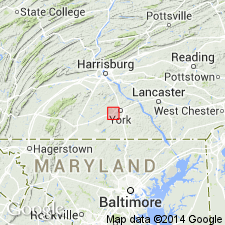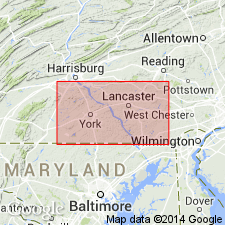
- Usage in publication:
-
- Willis Run Member
- Modifications:
-
- Named
- Dominant lithology:
-
- Limestone
- AAPG geologic province:
-
- Piedmont-Blue Ridge province
Summary:
Ledger Formation in the West York block of the Conestoga Valley, southeastern PA, is here subdivided into a lower dolomite member, the Willis Run Member (new name), and an upper dolomite member. Unit has not been previously subdivided, but described as approximately 1000 ft of pure dolomite. In area of report, the Willis Run Member is described as predominantly limestone with some dolomite and is thought to represent a deeper shelf environment than the upper and lower dolomites. At Delta Carbonate quarry, this middle limestone is more than 200 ft thick and contains fossils confirming an Early Cambrian age for the lower Ledger.
Source: GNU records (USGS DDS-6; Reston GNULEX).

- Usage in publication:
-
- Willis Run Member
- Modifications:
-
- Overview
- AAPG geologic province:
-
- Piedmont-Blue Ridge province
Summary:
The Willis Run Member, a newly discovered interval of limestone within the Ledger Formation in the West York Block (Ganis and Hopkins, this report) "has provided valuable insights to the age and environmental conditions of Ledger deposition." In the J.E. Baker Quarry, member exhibits great uniformity, in contrast to the other carbonate units. It consists of moderately bioturbate, thinly bedded, somewhat nodular lime mudstone to wackestone with abundant thin dolomitic laminae. Generally fine-grained character, extensive bioturbation, and absence of shallow water features indicate deposition is a fairly deep subtidal environment below storm wave base. Unit contains a single, distinctive horizon--a highly siliceous, pyritic bed overlain by very dark (organic-rich) limestone. Unit in drill cores and small pasture exposures near the quarry are quite different. Here the Willis Run contains cross-stratified oolitic lime grainstones and shows hematitic staining. Fenestral lime mudstone (algal boundstone?) was seen in drill core and one field exposure revealed a reef facies of stromatolitic lime boundstone.
Source: GNU records (USGS DDS-6; Reston GNULEX).
For more information, please contact Nancy Stamm, Geologic Names Committee Secretary.
Asterisk (*) indicates published by U.S. Geological Survey authors.
"No current usage" (†) implies that a name has been abandoned or has fallen into disuse. Former usage and, if known, replacement name given in parentheses ( ).
Slash (/) indicates name conflicts with nomenclatural guidelines (CSN, 1933; ACSN, 1961, 1970; NACSN, 1983, 2005, 2021). May be explained within brackets ([ ]).

